Single View Learning in Action Recognition
Gaurvi Goyal,
Nicoletta Noceti,
Francesca Odone

Auto-TLDR; Cross-View Action Recognition Using Domain Adaptation for Knowledge Transfer
Similar papers
A Grid-Based Representation for Human Action Recognition
Soufiane Lamghari, Guillaume-Alexandre Bilodeau, Nicolas Saunier

Auto-TLDR; GRAR: Grid-based Representation for Action Recognition in Videos
Abstract Slides Poster Similar
Self-Supervised Joint Encoding of Motion and Appearance for First Person Action Recognition
Mirco Planamente, Andrea Bottino, Barbara Caputo

Auto-TLDR; A Single Stream Architecture for Egocentric Action Recognition from the First-Person Point of View
Abstract Slides Poster Similar
Learnable Higher-Order Representation for Action Recognition

Auto-TLDR; Learningable Higher-Order Operations for Spatiotemporal Dynamics in Video Recognition
Feature-Supervised Action Modality Transfer
Fida Mohammad Thoker, Cees Snoek

Auto-TLDR; Cross-Modal Action Recognition and Detection in Non-RGB Video Modalities by Learning from Large-Scale Labeled RGB Data
Abstract Slides Poster Similar
3D Attention Mechanism for Fine-Grained Classification of Table Tennis Strokes Using a Twin Spatio-Temporal Convolutional Neural Networks
Pierre-Etienne Martin, Jenny Benois-Pineau, Renaud Péteri, Julien Morlier
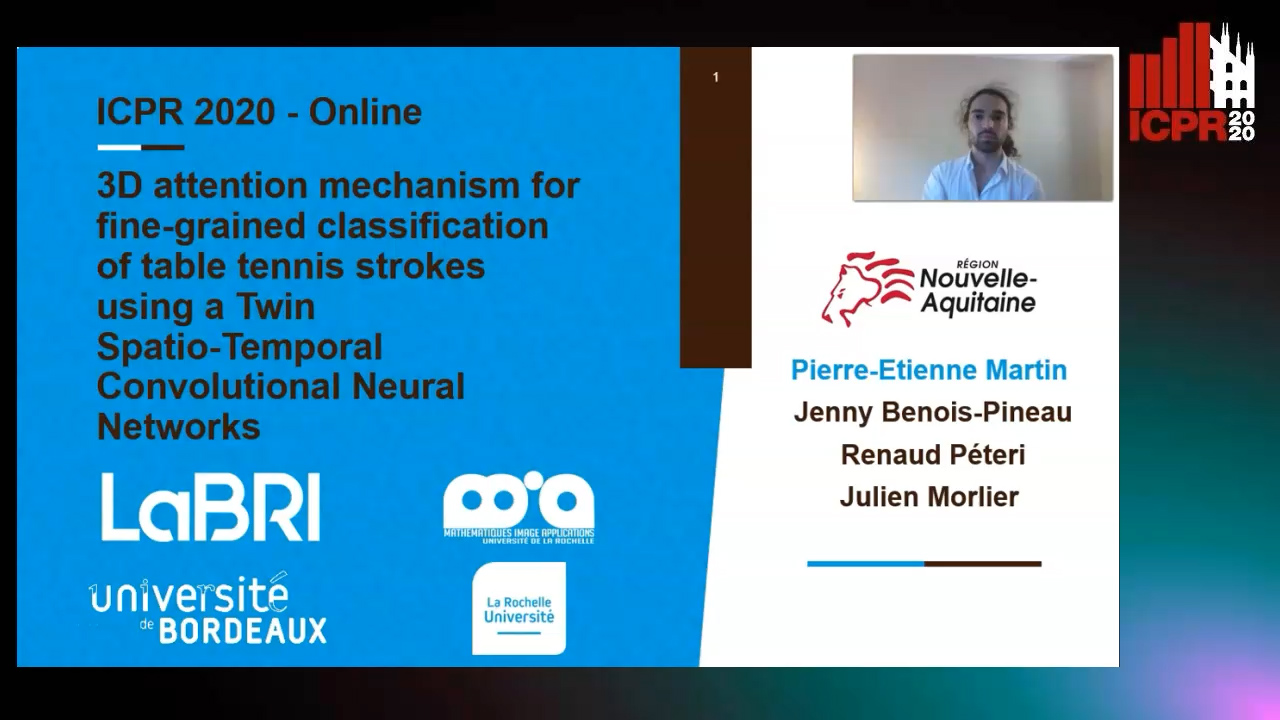
Auto-TLDR; Attentional Blocks for Action Recognition in Table Tennis Strokes
Abstract Slides Poster Similar
MixTConv: Mixed Temporal Convolutional Kernels for Efficient Action Recognition
Kaiyu Shan, Yongtao Wang, Zhi Tang, Ying Chen, Yangyan Li

Auto-TLDR; Mixed Temporal Convolution for Action Recognition
Abstract Slides Poster Similar
Vision-Based Multi-Modal Framework for Action Recognition
Djamila Romaissa Beddiar, Mourad Oussalah, Brahim Nini

Auto-TLDR; Multi-modal Framework for Human Activity Recognition Using RGB, Depth and Skeleton Data
Abstract Slides Poster Similar
TinyVIRAT: Low-Resolution Video Action Recognition
Ugur Demir, Yogesh Rawat, Mubarak Shah

Auto-TLDR; TinyVIRAT: A Progressive Generative Approach for Action Recognition in Videos
Abstract Slides Poster Similar
Learning Dictionaries of Kinematic Primitives for Action Classification
Alessia Vignolo, Nicoletta Noceti, Alessandra Sciutti, Francesca Odone, Giulio Sandini
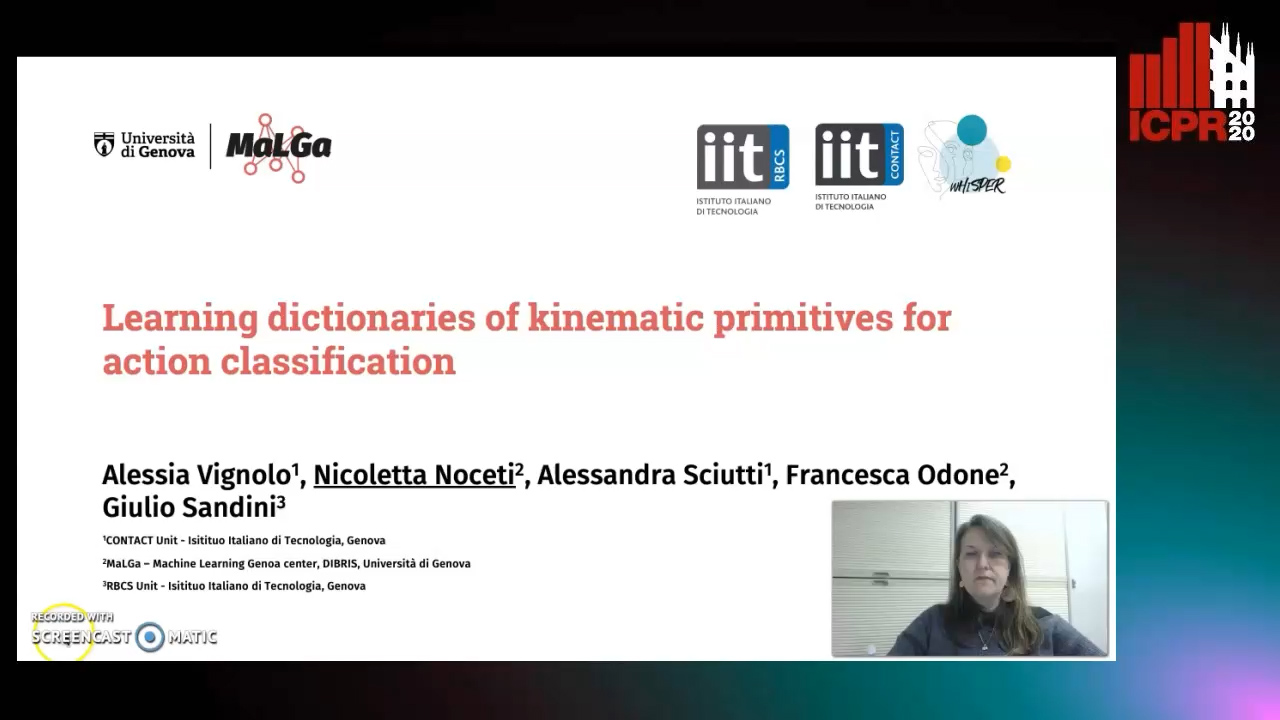
Auto-TLDR; Action Understanding using Visual Motion Primitives
Abstract Slides Poster Similar
Attention-Driven Body Pose Encoding for Human Activity Recognition
Bappaditya Debnath, Swagat Kumar, Marry O'Brien, Ardhendu Behera

Auto-TLDR; Attention-based Body Pose Encoding for Human Activity Recognition
Abstract Slides Poster Similar
Learning Group Activities from Skeletons without Individual Action Labels
Fabio Zappardino, Tiberio Uricchio, Lorenzo Seidenari, Alberto Del Bimbo

Auto-TLDR; Lean Pose Only for Group Activity Recognition
Extracting Action Hierarchies from Action Labels and their Use in Deep Action Recognition
Konstadinos Bacharidis, Antonis Argyros

Auto-TLDR; Exploiting the Information Content of Language Label Associations for Human Action Recognition
Abstract Slides Poster Similar
JT-MGCN: Joint-Temporal Motion Graph Convolutional Network for Skeleton-Based Action Recognition

Auto-TLDR; Joint-temporal Motion Graph Convolutional Networks for Action Recognition
A Detection-Based Approach to Multiview Action Classification in Infants
Carolina Pacheco, Effrosyni Mavroudi, Elena Kokkoni, Herbert Tanner, Rene Vidal

Auto-TLDR; Multiview Action Classification for Infants in a Pediatric Rehabilitation Environment
Vertex Feature Encoding and Hierarchical Temporal Modeling in a Spatio-Temporal Graph Convolutional Network for Action Recognition
Konstantinos Papadopoulos, Enjie Ghorbel, Djamila Aouada, Bjorn Ottersten
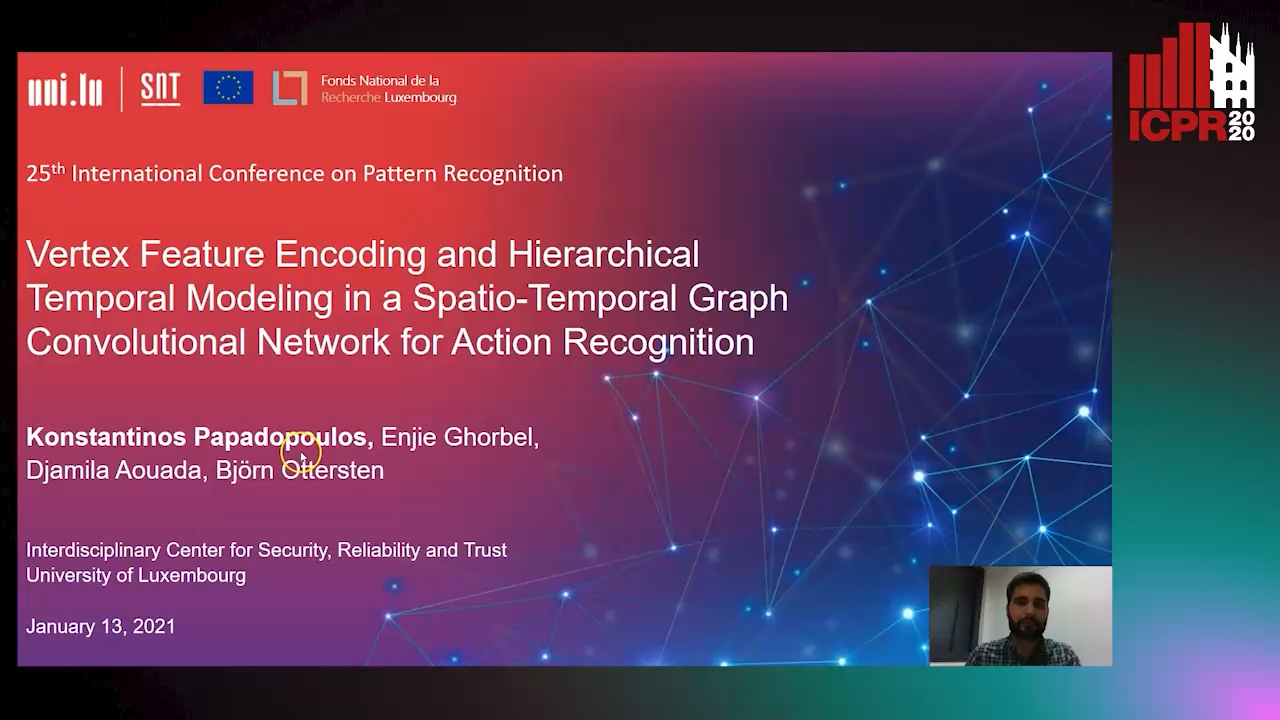
Auto-TLDR; Spatio-Temporal Graph Convolutional Network for Skeleton-Based Action Recognition
Abstract Slides Poster Similar
What and How? Jointly Forecasting Human Action and Pose
Yanjun Zhu, Yanxia Zhang, Qiong Liu, Andreas Girgensohn

Auto-TLDR; Forecasting Human Actions and Motion Trajectories with Joint Action Classification and Pose Regression
Abstract Slides Poster Similar
Channel-Wise Dense Connection Graph Convolutional Network for Skeleton-Based Action Recognition
Michael Lao Banteng, Zhiyong Wu
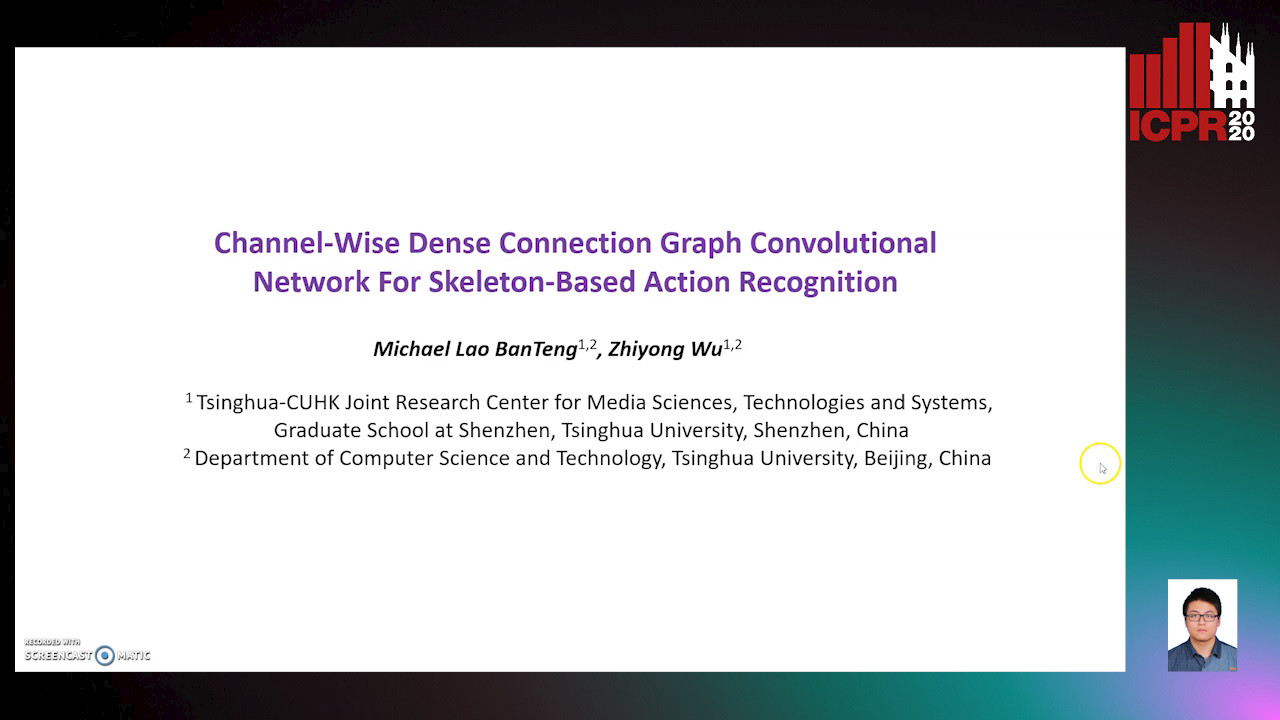
Auto-TLDR; Two-stream channel-wise dense connection GCN for human action recognition
Abstract Slides Poster Similar
Temporal Attention-Augmented Graph Convolutional Network for Efficient Skeleton-Based Human Action Recognition
Negar Heidari, Alexandros Iosifidis

Auto-TLDR; Temporal Attention Module for Efficient Graph Convolutional Network-based Action Recognition
Abstract Slides Poster Similar
RWF-2000: An Open Large Scale Video Database for Violence Detection
Ming Cheng, Kunjing Cai, Ming Li

Auto-TLDR; Flow Gated Network for Violence Detection in Surveillance Cameras
Abstract Slides Poster Similar
DeepPear: Deep Pose Estimation and Action Recognition
Wen-Jiin Tsai, You-Ying Jhuang

Auto-TLDR; Human Action Recognition Using RGB Video Using 3D Human Pose and Appearance Features
Abstract Slides Poster Similar
A Multi-Task Neural Network for Action Recognition with 3D Key-Points
Rongxiao Tang, Wang Luyang, Zhenhua Guo

Auto-TLDR; Multi-task Neural Network for Action Recognition and 3D Human Pose Estimation
Abstract Slides Poster Similar
MFI: Multi-Range Feature Interchange for Video Action Recognition
Sikai Bai, Qi Wang, Xuelong Li

Auto-TLDR; Multi-range Feature Interchange Network for Action Recognition in Videos
Abstract Slides Poster Similar
Towards Practical Compressed Video Action Recognition: A Temporal Enhanced Multi-Stream Network
Bing Li, Longteng Kong, Dongming Zhang, Xiuguo Bao, Di Huang, Yunhong Wang

Auto-TLDR; TEMSN: Temporal Enhanced Multi-Stream Network for Compressed Video Action Recognition
Abstract Slides Poster Similar
RMS-Net: Regression and Masking for Soccer Event Spotting
Matteo Tomei, Lorenzo Baraldi, Simone Calderara, Simone Bronzin, Rita Cucchiara

Auto-TLDR; An Action Spotting Network for Soccer Videos
Abstract Slides Poster Similar
Subspace Clustering for Action Recognition with Covariance Representations and Temporal Pruning
Giancarlo Paoletti, Jacopo Cavazza, Cigdem Beyan, Alessio Del Bue

Auto-TLDR; Unsupervised Learning for Human Action Recognition from Skeletal Data
Pose-Based Body Language Recognition for Emotion and Psychiatric Symptom Interpretation
Zhengyuan Yang, Amanda Kay, Yuncheng Li, Wendi Cross, Jiebo Luo

Auto-TLDR; Body Language Based Emotion Recognition for Psychiatric Symptoms Prediction
Abstract Slides Poster Similar
Developing Motion Code Embedding for Action Recognition in Videos
Maxat Alibayev, David Andrea Paulius, Yu Sun

Auto-TLDR; Motion Embedding via Motion Codes for Action Recognition
Abstract Slides Poster Similar
Modeling Long-Term Interactions to Enhance Action Recognition
Alejandro Cartas, Petia Radeva, Mariella Dimiccoli

Auto-TLDR; A Hierarchical Long Short-Term Memory Network for Action Recognition in Egocentric Videos
Abstract Slides Poster Similar
Late Fusion of Bayesian and Convolutional Models for Action Recognition
Camille Maurice, Francisco Madrigal, Frederic Lerasle

Auto-TLDR; Fusion of Deep Neural Network and Bayesian-based Approach for Temporal Action Recognition
Abstract Slides Poster Similar
Recurrent Graph Convolutional Networks for Skeleton-Based Action Recognition
Guangming Zhu, Lu Yang, Liang Zhang, Peiyi Shen, Juan Song
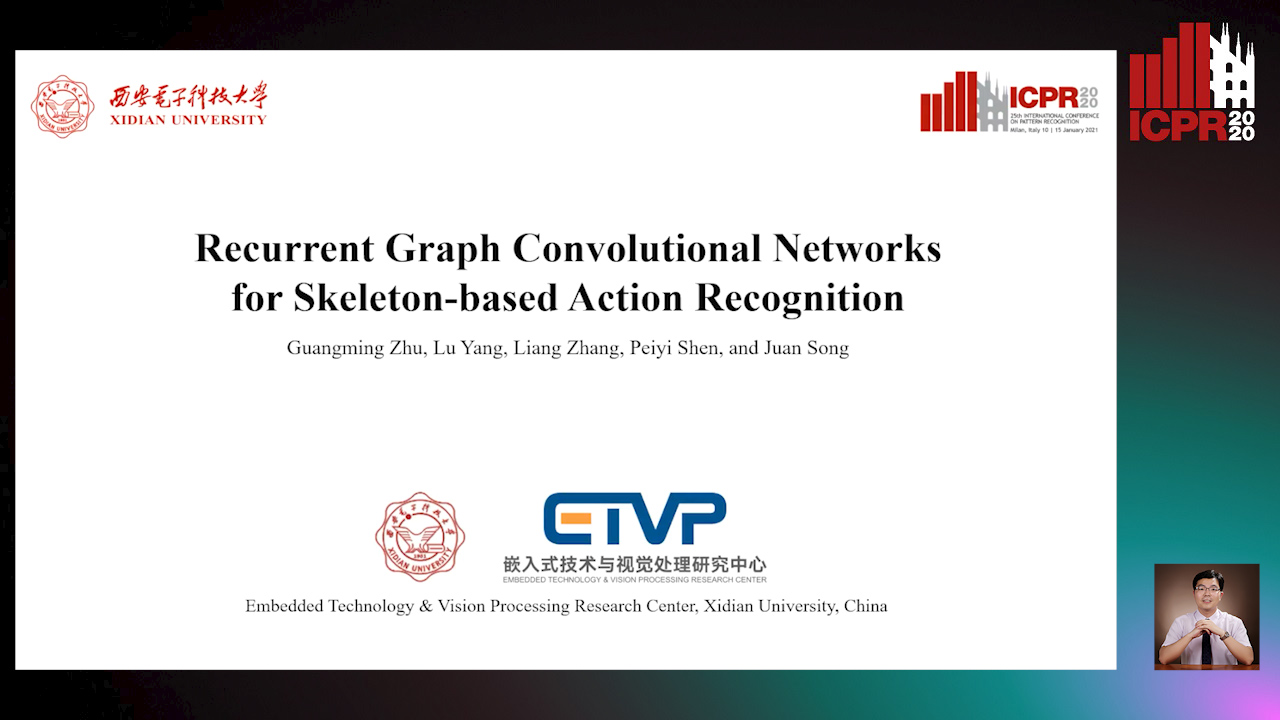
Auto-TLDR; Recurrent Graph Convolutional Network for Human Action Recognition
Abstract Slides Poster Similar
Attention-Oriented Action Recognition for Real-Time Human-Robot Interaction
Ziyang Song, Ziyi Yin, Zejian Yuan, Chong Zhang, Wanchao Chi, Yonggen Ling, Shenghao Zhang

Auto-TLDR; Attention-Oriented Multi-Level Network for Action Recognition in Interaction Scenes
Abstract Slides Poster Similar
SL-DML: Signal Level Deep Metric Learning for Multimodal One-Shot Action Recognition
Raphael Memmesheimer, Nick Theisen, Dietrich Paulus
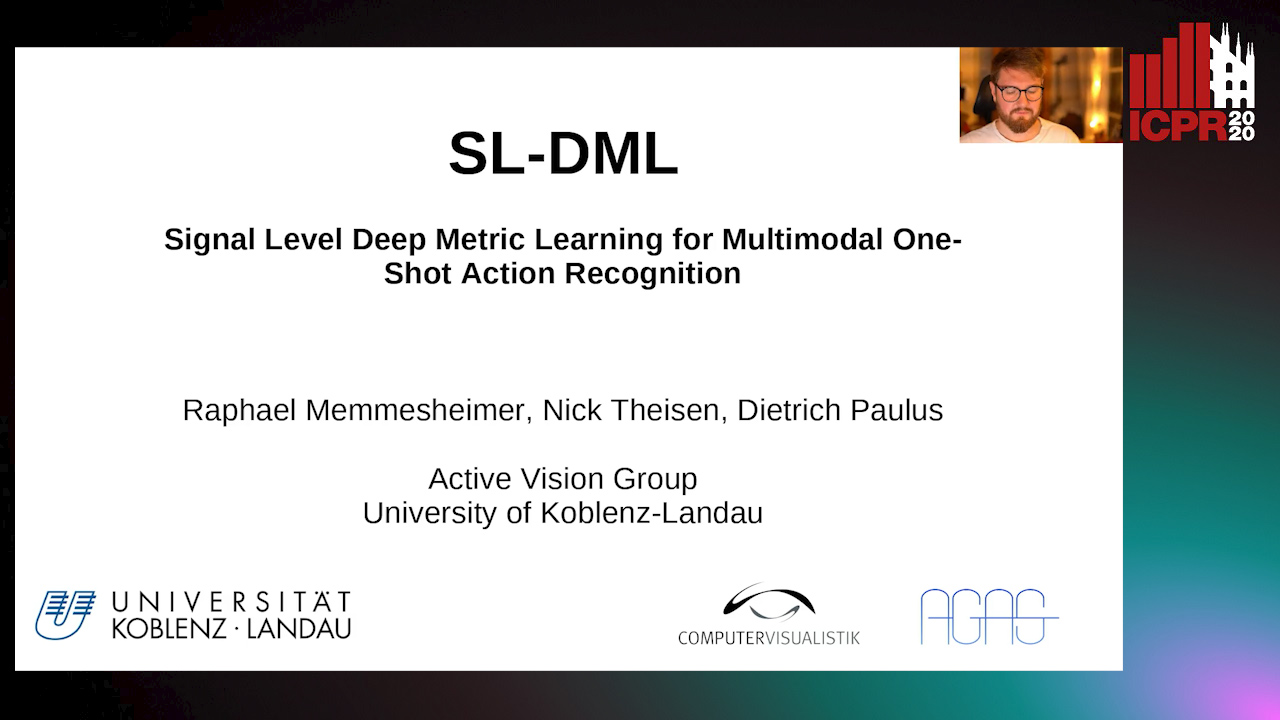
Auto-TLDR; One-Shot Action Recognition using Metric Learning
Temporal Binary Representation for Event-Based Action Recognition
Simone Undri Innocenti, Federico Becattini, Federico Pernici, Alberto Del Bimbo
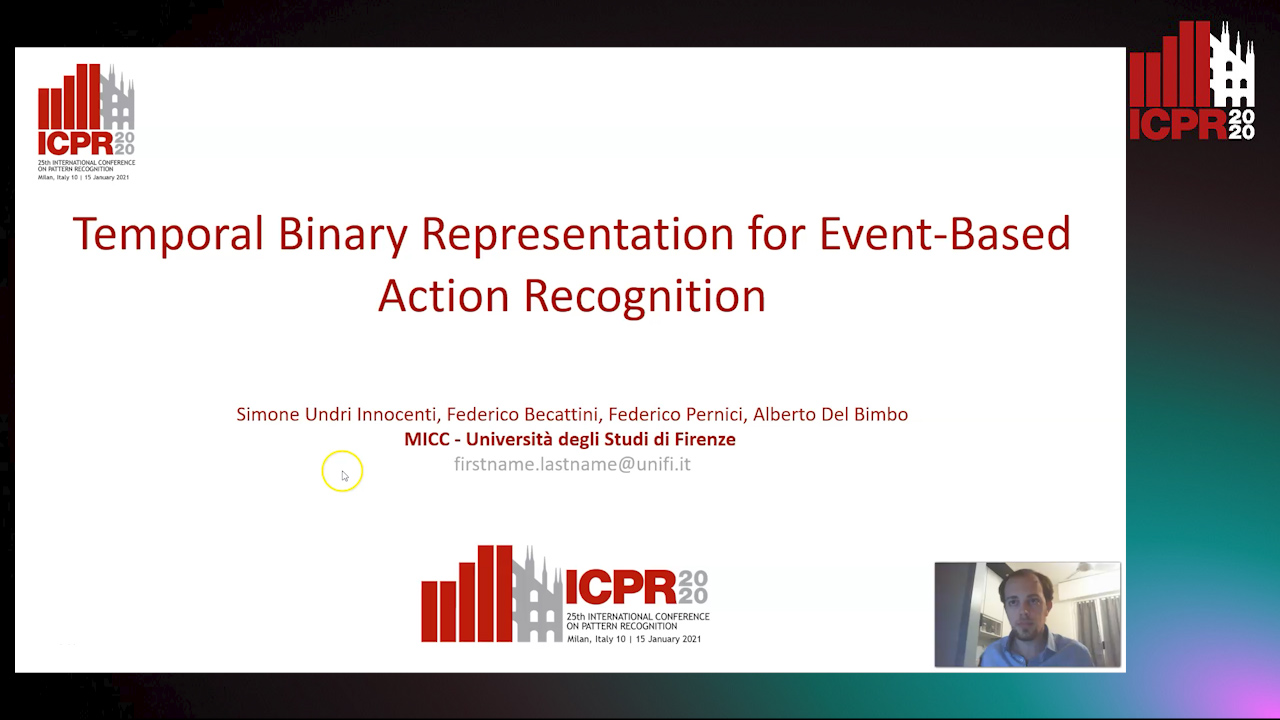
Auto-TLDR; Temporal Binary Representation for Gesture Recognition
Abstract Slides Poster Similar
Activity Recognition Using First-Person-View Cameras Based on Sparse Optical Flows
Peng-Yuan Kao, Yan-Jing Lei, Chia-Hao Chang, Chu-Song Chen, Ming-Sui Lee, Yi-Ping Hung

Auto-TLDR; 3D Convolutional Neural Network for Activity Recognition with FPV Videos
Abstract Slides Poster Similar
Supervised Domain Adaptation Using Graph Embedding
Lukas Hedegaard, Omar Ali Sheikh-Omar, Alexandros Iosifidis

Auto-TLDR; Domain Adaptation from the Perspective of Multi-view Graph Embedding and Dimensionality Reduction
Abstract Slides Poster Similar
Motion Complementary Network for Efficient Action Recognition
Ke Cheng, Yifan Zhang, Chenghua Li, Jian Cheng, Hanqing Lu

Auto-TLDR; Efficient Motion Complementary Network for Action Recognition
Abstract Slides Poster Similar
Temporal Extension Module for Skeleton-Based Action Recognition

Auto-TLDR; Extended Temporal Graph for Action Recognition with Kinetics-Skeleton
Abstract Slides Poster Similar
Space-Time Domain Tensor Neural Networks: An Application on Human Pose Classification
Konstantinos Makantasis, Athanasios Voulodimos, Anastasios Doulamis, Nikolaos Doulamis, Nikolaos Bakalos

Auto-TLDR; Tensor-Based Neural Network for Spatiotemporal Pose Classifiaction using Three-Dimensional Skeleton Data
Abstract Slides Poster Similar
A Two-Stream Recurrent Network for Skeleton-Based Human Interaction Recognition
Qianhui Men, Edmond S. L. Ho, Shum Hubert P. H., Howard Leung

Auto-TLDR; Two-Stream Recurrent Neural Network for Human-Human Interaction Recognition
Abstract Slides Poster Similar
Flow-Guided Spatial Attention Tracking for Egocentric Activity Recognition

Auto-TLDR; flow-guided spatial attention tracking for egocentric activity recognition
Abstract Slides Poster Similar
Temporally Coherent Embeddings for Self-Supervised Video Representation Learning
Joshua Knights, Ben Harwood, Daniel Ward, Anthony Vanderkop, Olivia Mackenzie-Ross, Peyman Moghadam

Auto-TLDR; Temporally Coherent Embeddings for Self-supervised Video Representation Learning
Abstract Slides Poster Similar
Gabriella: An Online System for Real-Time Activity Detection in Untrimmed Security Videos
Mamshad Nayeem Rizve, Ugur Demir, Praveen Praveen Tirupattur, Aayush Jung Rana, Kevin Duarte, Ishan Rajendrakumar Dave, Yogesh Rawat, Mubarak Shah

Auto-TLDR; Gabriella: A Real-Time Online System for Activity Detection in Surveillance Videos
SCA Net: Sparse Channel Attention Module for Action Recognition
Hang Song, Yonghong Song, Yuanlin Zhang
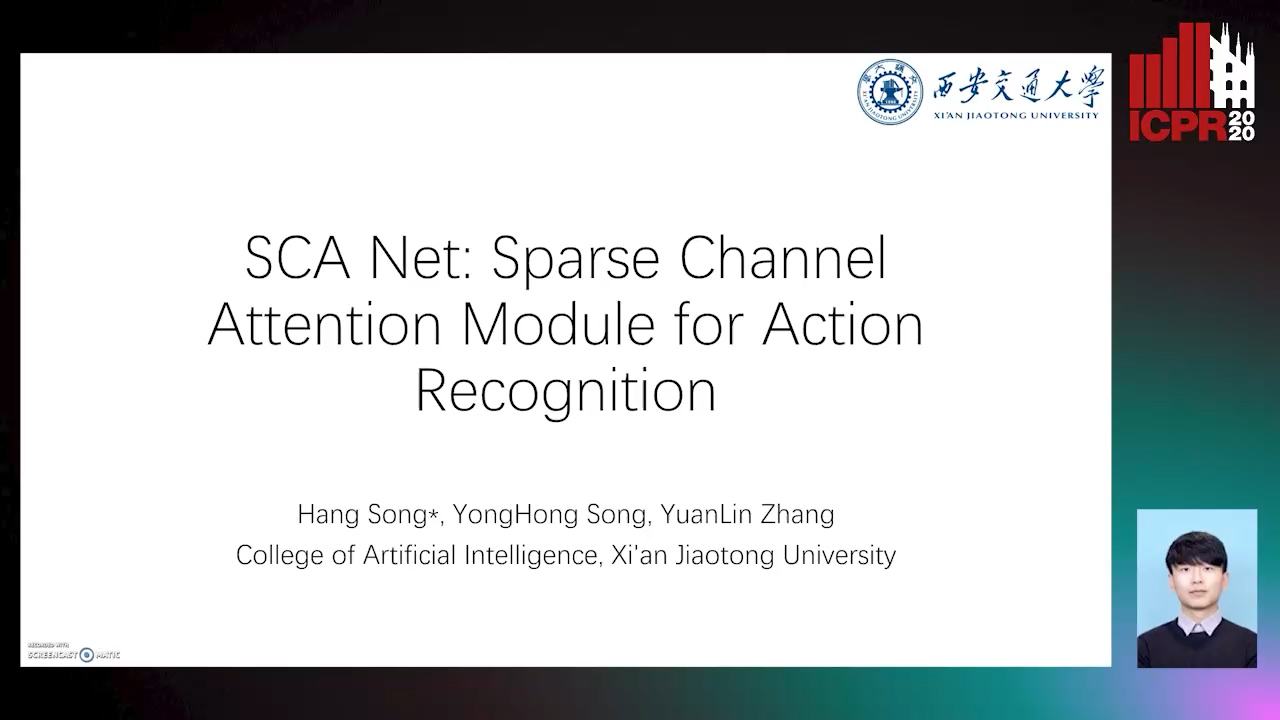
Auto-TLDR; SCA Net: Efficient Group Convolution for Sparse Channel Attention
Abstract Slides Poster Similar
From Human Pose to On-Body Devices for Human-Activity Recognition
Fernando Moya Rueda, Gernot Fink

Auto-TLDR; Transfer Learning from Human Pose Estimation for Human Activity Recognition using Inertial Measurements from On-Body Devices
Abstract Slides Poster Similar
2D Deep Video Capsule Network with Temporal Shift for Action Recognition
Théo Voillemin, Hazem Wannous, Jean-Philippe Vandeborre
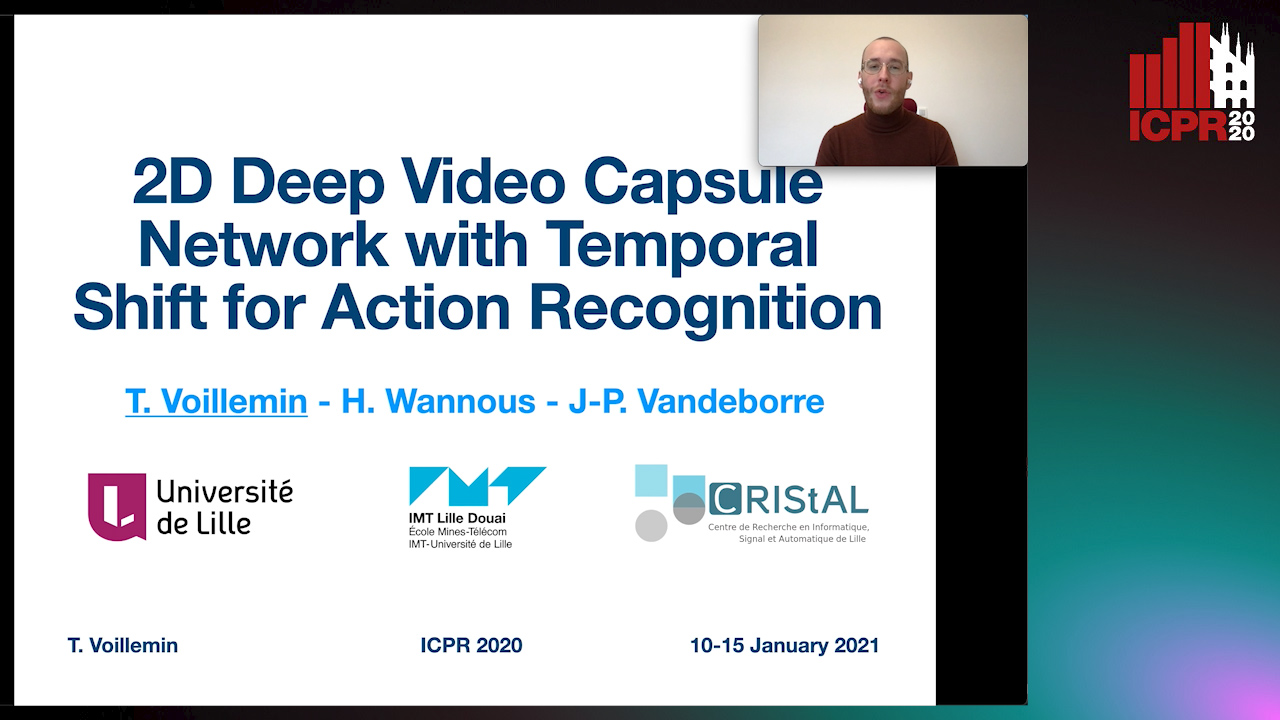
Auto-TLDR; Temporal Shift Module over Capsule Network for Action Recognition in Continuous Videos
Knowledge Distillation for Action Anticipation Via Label Smoothing
Guglielmo Camporese, Pasquale Coscia, Antonino Furnari, Giovanni Maria Farinella, Lamberto Ballan
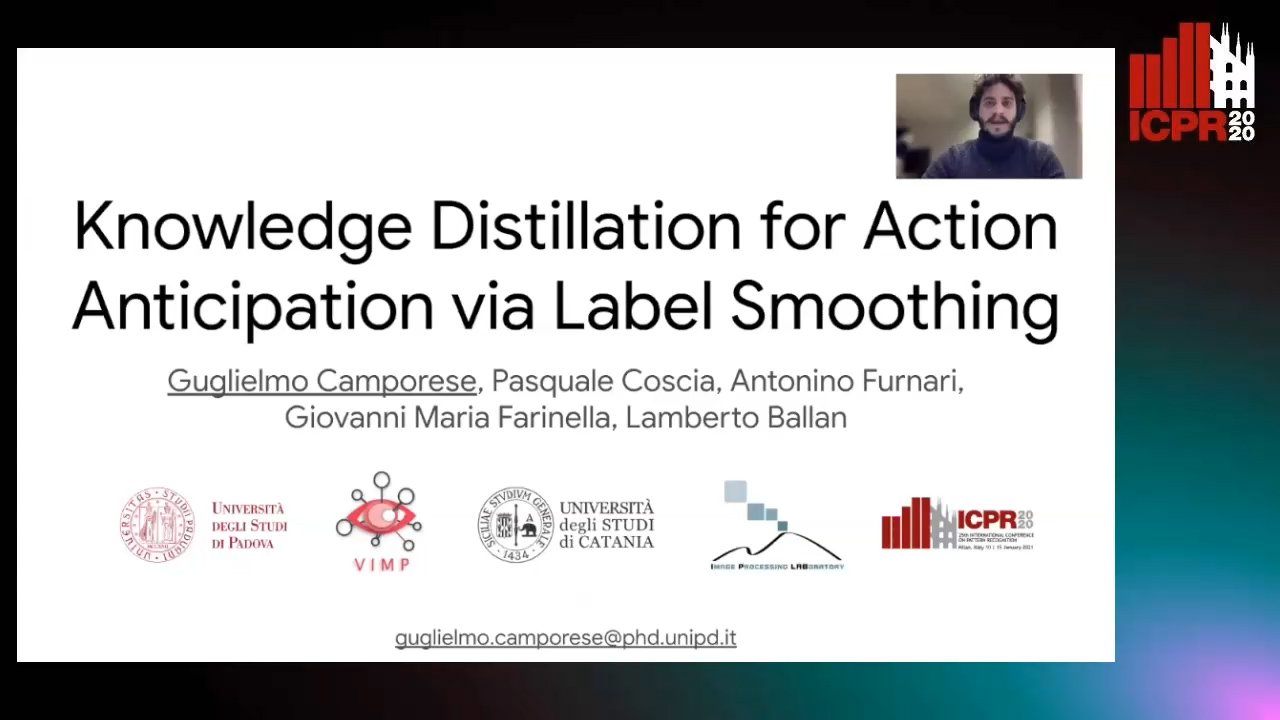
Auto-TLDR; A Multi-Modal Framework for Action Anticipation using Long Short-Term Memory Networks
Abstract Slides Poster Similar
Pose-Aware Multi-Feature Fusion Network for Driver Distraction Recognition
Mingyan Wu, Xi Zhang, Linlin Shen, Hang Yu
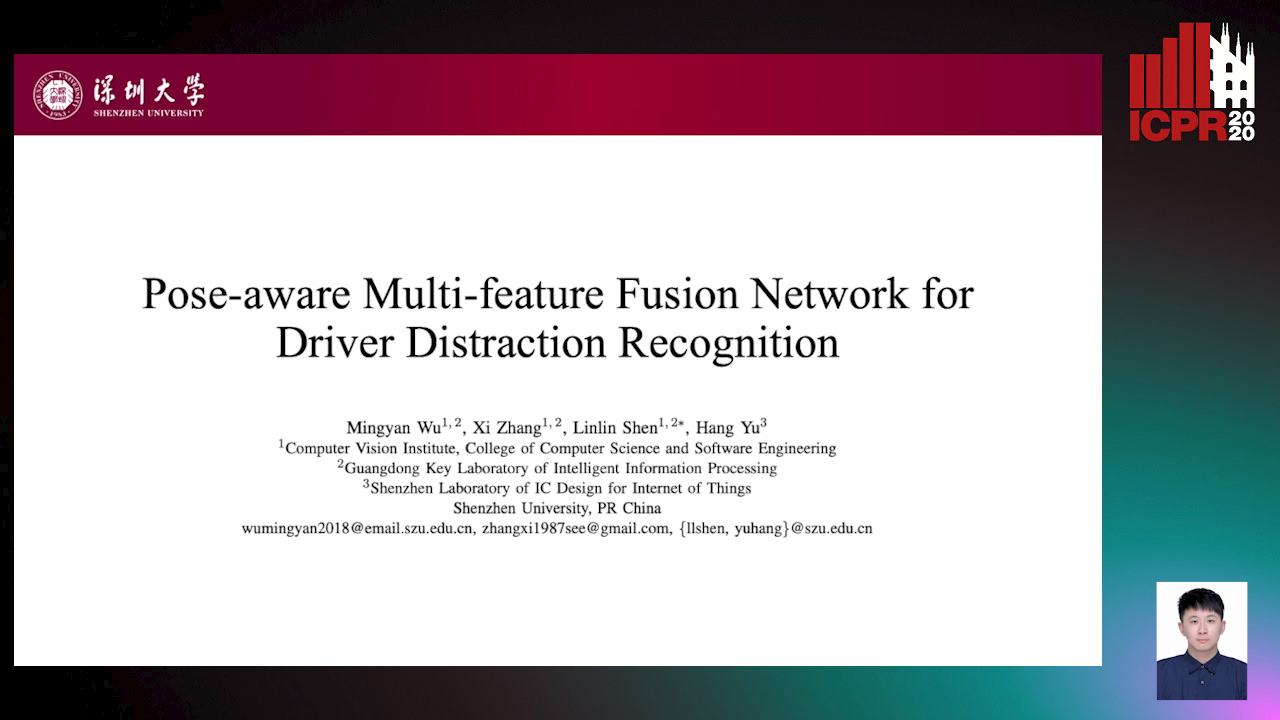
Auto-TLDR; Multi-Feature Fusion Network for Distracted Driving Detection using Pose Estimation
Abstract Slides Poster Similar
Learning Recurrent High-Order Statistics for Skeleton-Based Hand Gesture Recognition
Xuan Son Nguyen, Luc Brun, Olivier Lezoray, Sébastien Bougleux
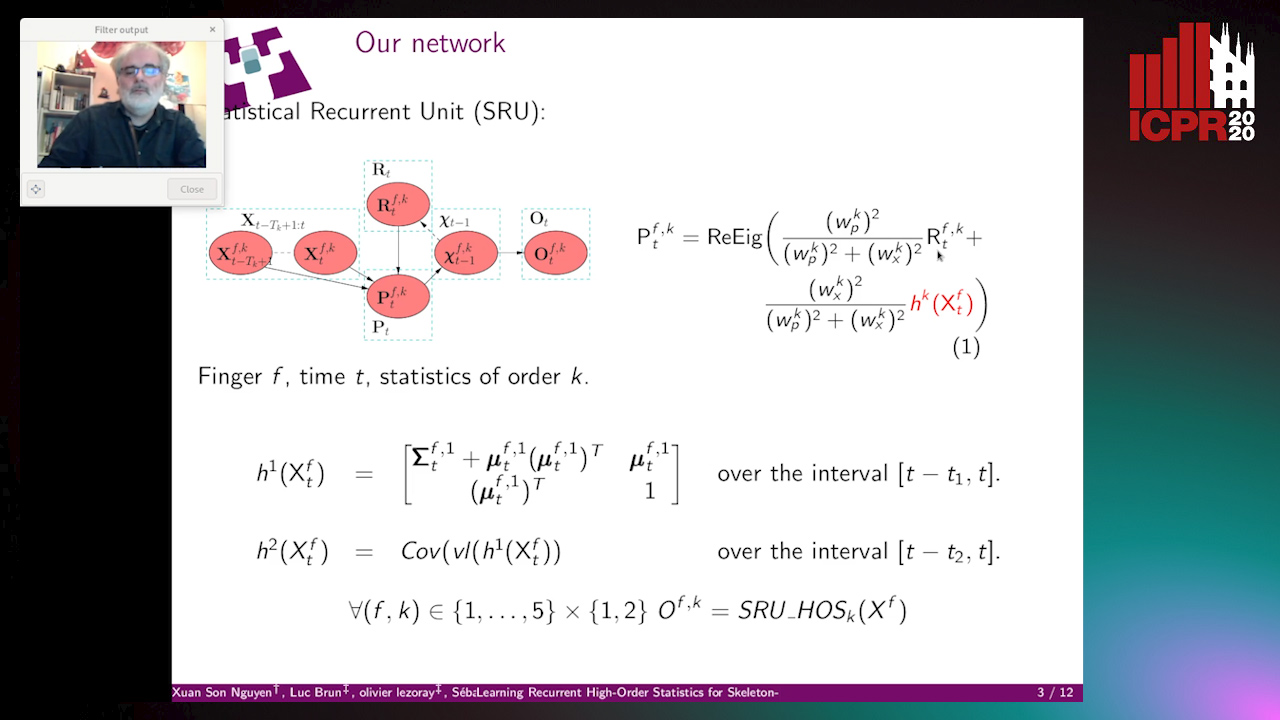
Auto-TLDR; Exploiting High-Order Statistics in Recurrent Neural Networks for Hand Gesture Recog-nition